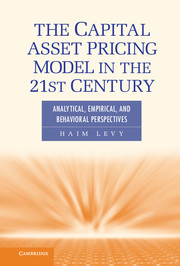 The Capital Asset Pricing Model in the 21st Century
The Capital Asset Pricing Model in the 21st Century Book contents
- Frontmatter
- Contents
- Preface
- 1 Introduction
- 2 Expected Utility Theory
- 3 Expected Utility and Investment Decision Rules
- 4 The Mean-Variance Rule (M-V Rule)
- 5 The Capital Asset Pricing Model
- 6 Extensions of the Capital Asset Pricing Model
- 7 The Capital Asset Pricing Model Cannot Be Rejected
- 8 Theoretical and Empirical Criticism of the Mean-Variance Rule
- 9 Prospect Theory and Expected Utility
- 10 Cumulative Decision Weights
- 11 The Mean-Variance Rule, the Capital Asset Pricing Model, and the Cumulative Prospect Theory
- References
- Name Index
- Subject Index
9 - Prospect Theory and Expected Utility
Published online by Cambridge University Press: 05 June 2012
- Frontmatter
- Contents
- Preface
- 1 Introduction
- 2 Expected Utility Theory
- 3 Expected Utility and Investment Decision Rules
- 4 The Mean-Variance Rule (M-V Rule)
- 5 The Capital Asset Pricing Model
- 6 Extensions of the Capital Asset Pricing Model
- 7 The Capital Asset Pricing Model Cannot Be Rejected
- 8 Theoretical and Empirical Criticism of the Mean-Variance Rule
- 9 Prospect Theory and Expected Utility
- 10 Cumulative Decision Weights
- 11 The Mean-Variance Rule, the Capital Asset Pricing Model, and the Cumulative Prospect Theory
- References
- Name Index
- Subject Index
Summary
Introduction
In a series of laboratory experiments, Kahneman and Tversky (K&T) find that the subjects participating in these experiments do not choose among various prospects by the expected utility paradigm, as one would predict. Moreover, experimental studies reveal that in the domain of negative outcomes, risk seeking characterizes the subjects’ choices, which is in contradiction to the risk-aversion assumption, an assumption that is usually made in the derivation of the Mean-Variance (M-V) rule and the Capital Asset Pricing Model (CAPM). In this chapter, we focus on Prospect Theory (PT) as suggested in K&T's 1979 article, and in Chapter 10, we discuss the advances and modifications suggested to the original theory. The main difference between the original model and the advanced model, known as Cumulative PT (CPT; see Chapter 10), refer to the way decision weights are determined. Also, in the advanced model, estimates of the value function and the decision weights function are provided. As we shall see in these two chapters, each decision weight method has its pros and cons, and the modified version does not have a clear advantage over the original version. In Chapter 11, we analyze the M-V rule and the CAPM within the PT paradigm. Surprisingly, we show that under a wide range of conditions, both the common investment decision rules and the CPT, the modified PT model, can coexist.
The seminal PT article by K&T, which was published in 1979, has had a monumental impact on economic and financial research. Actually, it constitutes a landmark in the development of new research fields, nowadays known as behavioral finance and behavioral economics. Moreover, new journals have been established that are completely devoted to experimental economics and to behavioral finance and behavioral economics.
- Type
- Chapter
- Information
- The Capital Asset Pricing Model in the 21st CenturyAnalytical, Empirical, and Behavioral Perspectives, pp. 299 - 332Publisher: Cambridge University PressPrint publication year: 2011


